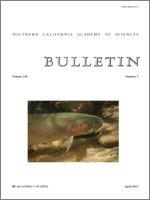The life history and habitat interactions of southern Oncorhynchus mykiss populations have received less attention than their Pacific Northwest counterparts. In this article we create a conceptual model describing the factors affecting O. mykiss population dynamics in Topanga Creek, Los Angeles County, California to understand the process that led to extirpation following floods in 1980 and 1983, re-colonization in the late 1990's, and continued persistence. We conclude that key factors influencing population dynamics include life-history variability with both resident and anadromous individuals, population spatial structure connecting Topanga Creek with other watersheds within the metapopulation, exclusive distribution within the mainstem Topanga Creek, high-quality summer and winter rearing habit, and food availability sufficient to maintain growth at high temperatures. Protecting the population in Topanga Creek from future extirpation should include restoration of the lagoon, and preventing changes to the flow regime and water quality.
How to translate text using browser tools
1 April 2011
Colonization and Persistence of a Southern California Steelhead (Oncorhynchus mykiss) Population
Ethan Bell,
Rosi Dagit,
Frank Ligon
ACCESS THE FULL ARTICLE





